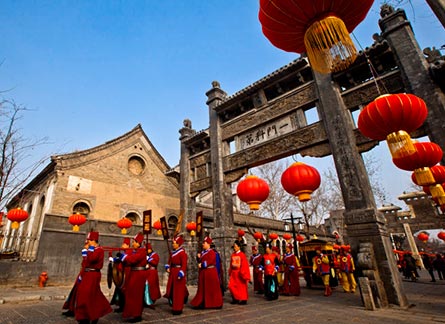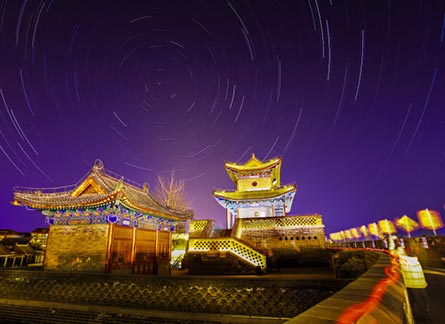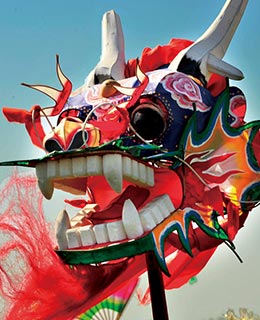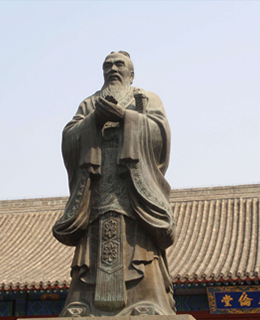

Comprehensive Shandong: Qingdao, Qufu, and Mount Tai in Ten Days
Highlights
• Explore all of Shandong’s top sights in one go
• Visit the Tsingtao Beer Museum, where the world-famous beer comes from
• Visit the Confucius Temple which has been restored and expanded from dynasty to dynasty
• Marvel at Mt. Tai’s incredible views
• Learn about kite culture in the kite capital of the world: Weifang
• Check out Zhoucun Village, one of the origins of the Northern Silk Road in China
• Relax with the convenience of an English-speaking local tour guide and a driver
• Enjoy plenty of photo opportunities
Destination: Qingdao Weifang Zibo Taian Qufu Jinan Tour type: Private Total duration for each tour: Ten days Tour code: SD-10-01
Online booking

Firstly you’ll be met at Qingdao Airport by your tour guide, and taken to visit Zhanqiao Pier. This pier was built in 1891, and stretches 440 meters into the sea. Originally, the pier was a naval pier built by the Commander Deng Zhou, but has now been transformed into a popular tourist destination. Most famously, Zhanqiao Pier is the image used on the label of Tsingtao beer bottles and cans, so that’s why you might recognize it. Make sure you get plenty of photos of this iconic sight.
After that, you will be taken on a visit to St Michael’s Cathedral. Established in the early 1930s, St. Michael's was the Catholic church of Qingdao during its period of German occupation. It was then the largest building in Qingdao, and remains a shining example of Christian architecture. The locals simply call it ‘Catholic Church,’ as it is the main one. It is the seat of the Bishop of the Roman Catholic Diocese of Qingdao, and is located in the oldest part of the city.
Hotel: Qingdao

In the morning, you will go to Mount Laoshan, and go hiking in the beautiful fishing village where you can enjoy a nice mountain view as well as an ocean view, all in one. Make sure you take plenty of photographs and enjoy your escape from the hustle and bustle of the city.
In the afternoon, go to visit the Tsingtao Beer Museum, where you can learn about the complete process of making the world-famous Tsingtao beer and taste it too, as fresh as it gets. Outside of the museum is beer street, where you can sip even more of these refreshing suds that have brought the city so much attention throughout the years. In Qingdao, you’ll even be able to buy beer by the little plastic bag.
Hotel: Qingdao

On your third day, you’ll visit Weifang City, which is also known as the ‘kite capital of the world.’
In Weifang, you’ll visit Yangjiabu Folk Art Grand View Garden, which was formerly a kite factory. You’ll learn more about the production, printing, and designing of the kites. Afterwards you’ll get to visit the Weifang Kite Museum, which has collected more than one thousand delicate kites from all over the world. You’ll also be able to see all the different materials that are used to make the kites like you see them around the entire country in parks.
Hotel: Weifang

You’ll go to Zibo on the fourth day, and visit the Ma Hang Martyrdom Cemetary. The Spring and Autumn period Ma Hang martyrdom is cermetary from the time of the Qi monarch. This tomb was found to have more than 20 seats, measuring 70 meters long and 5 meters wide. Your tour guide will be able to go into more depth about the Spring and Autumn Period, an important time in Chinese history, especially in this region.
You will also go to visit the Chinese Ancient Chariots Museum, China’s most complete archaeological site of its kind with ancient chariots, funeral horses, as well as other cultural relics.
Hotel: Zibo

Today, you will visit E’Zhuang Village near Zibo, where fire-glazing techniques were first found in China. These techniques can be traced back to the Western Zhou Dynasty, and they have been listed on the national non-material cultural heritage list as a skill to be protected. You will learn more about this skill here.
After that, we will go to Zhoucun, which is one of the sources of the Chinese Northern Silk Road, and has some incredible beautiful ancient buildings. The buildings are well preserved and are a historical and cultural relic.
Hotel: Zibo

On the sixth day, you’ll visit the Great Wall of the Qi Dynasty, which can be traced back to the Spring and Autumn Period. This part of the wall originates from the Yellow River in the West, and heads East towards the Yellow Sea, stretching through 13 of Shandong’s counties for over 1,000 kilometers.
After this you will visit Lingyan Temple, one of the most famous Buddhist Temples in the Tang (618-907) and Song (960-1127) Dynasties. The Lingyan Temple, together with the Guoqing Temple in Tiantai Mountain, the Yuquan Temple at Wudang Mountain and the Qixia Temple at Qixia Mountain, are collectively called Chinese Big Four Jungles, and are also praised as the Four Taoist Miracles in the World.
Hotel: Tai’an City

Mount Tai, located in the middle of Shandong Province, spans across two cities: Tai’an City and Jinan City, covering a total area of 426 square kilometers. In 1987, the mountain was listed as a UNESCO Cultural and Natural World Heritage site.
Since ancient times, Mount Tai has been recognized as a holy and sacred Mountain, and has held the accolade of being the “Most Revered of the Five Sacred Mountains”. Furthermore, Mount Tai symbolizes peaceful life and a unified country. Because of that, for thousands of years, more than a dozen emperors paid their homage to the mountain. Vast quantities of poetry and stone inscriptions were left by emperors, poets and scholars of every era. In other words, Mount Tai has become the symbol of Chinese spirit.
Your tour at Mount Tai includes a cable car up, and many famous scenic spots on the mountain, such as the South Gate to Heaven (the last remaining gate of Mount Tai), Shiba Pan (some of the steepest steps), The Grand View Peak (a stone inscription left from Tang Dynasty (8th century)), the Jade Emperor Temple, and a cable car ride to take in the incredible views. You’ll be able to sit in the tea garden too, and enjoy the natural beauty.
Hotel: Tai’an City

Qufu is a city in southwestern Shandong Province with an urban population of about 60,000 people. The entire administrative region has about 650,000 inhabitants.
Qufu is best known as the hometown of Confucius. The city contains numerous historic palaces, temples and cemeteries. The three most famous cultural sites of the city, collectively known as San Kong, or "The Three Confucian sites", are the Temple of Confucius, the Cemetery of Confucius, and the Kong Family Mansion. Together these three sites have been listed as a UNESCO World Heritage Site since 1994.
In the morning, you will be picked up at Qufu train station or your hotel, depending on whether you are coming into Qufu for just the day, or whether you are already staying there.
Youl’ll start with a visit to Confucius Temple, or Kong Miao, as it is known in Chinese. The origins of the temple date back to the 5th Century B.C., as it was built shortly after Confucius’ death. In 478 B.C., Duke Ai of the state of Lu (in today's Shandong Province) built a temple honoring Confucius, who, at the time, was still largely unknown outside the province. By the 2nd Century B.C., the fame of Confucius had spread and the Han Emperor Wudi began offering sacrifices at this site in 205 B.C. The temple was expanded but subsequent generations of rulers, and for the next thousand years, untold numbers of buildings were built and torn down in many rounds of rebuilding.
After your visit to the temple, there will be time to taste some of the local cuisine, which your tour guide can help you understand.
Following lunch, you will visit the Kong Family Mansion, or Confucius’ Family Mansion. This is where both Confucius and his descendants allegedly lived for over 2,500 years. The yard boasts 466 rooms and myriad courtyards, most of which are off-limits to tourists, but there are enough open to give you a general idea of the grandeur of the place.
You’ll also visit the Cemetery of Confucius, which is where the Kong clan is all buried, as well as some of Confucius’ disciples. Construction on this cemetery was begun in 1331, but in total there have been 13 different renovations and extensions. By the late 18th century, the perimeter wall reached a length of 7.5 kilometers, enclosing an area of 3.6 square kilometers. The oldest graves found here date back to the Zhou Dynasty.
Hotel: Qufu

Today, you will head to and explore Jinan. Being the capital city of Shandong Province, Jinan is a middle sized city with a population of 8 million. With numerous natural springs scattered around the downtown area, Jinan is known as the city of springs.
First you will go to Daming Lake, the largest lake in the city which sports a constant water level, unaffected by heavy rains or drought. The lake is surrounded by a park with an ensemble of historical buildings, some of which stand on the islands located within the lake. You’ll have some time to enjoy the scenes here.
Afterwards, head to Baotu Spring Park which was declared the "Number One Spring under the Heaven.” This park is a culturally significant artesian karst spring, mentioned in one of the Five Classics of Chinese literature. It is probably the most wel renowned spring in the downtown area, with the water originating from an Ordovician karst aquifer underneath the city. As the terrain around Jinan slopes from the south of the city down to the north, the recharge area for the aquifer is located in the mountainous area to the south of the city.
Hotel: Jinan

Your tour ends here, you will be brought to the train station or the airport depending on how you are getting to your next destination.







